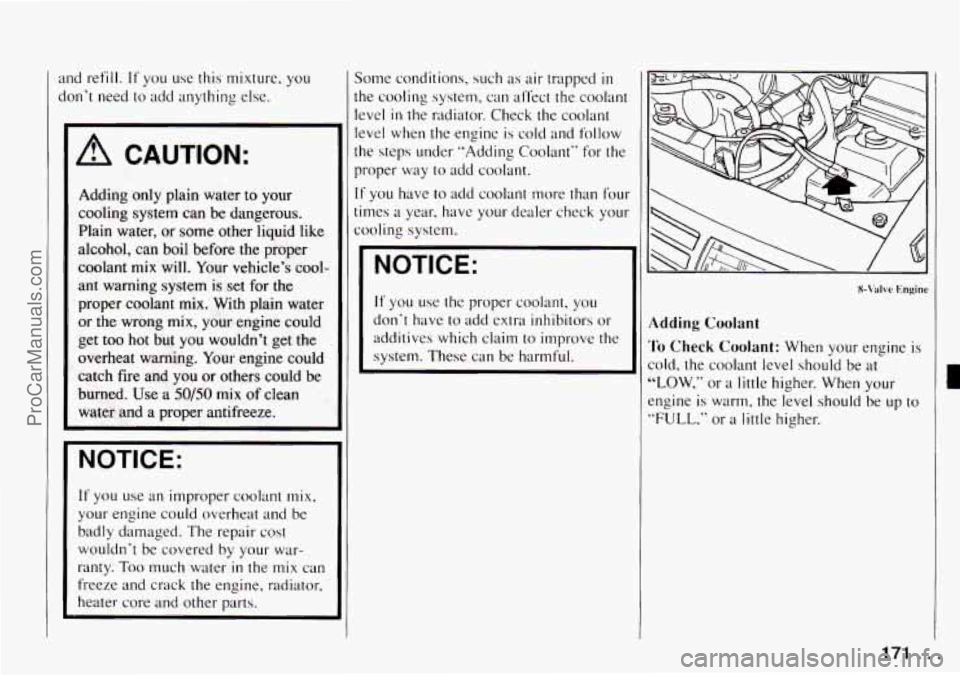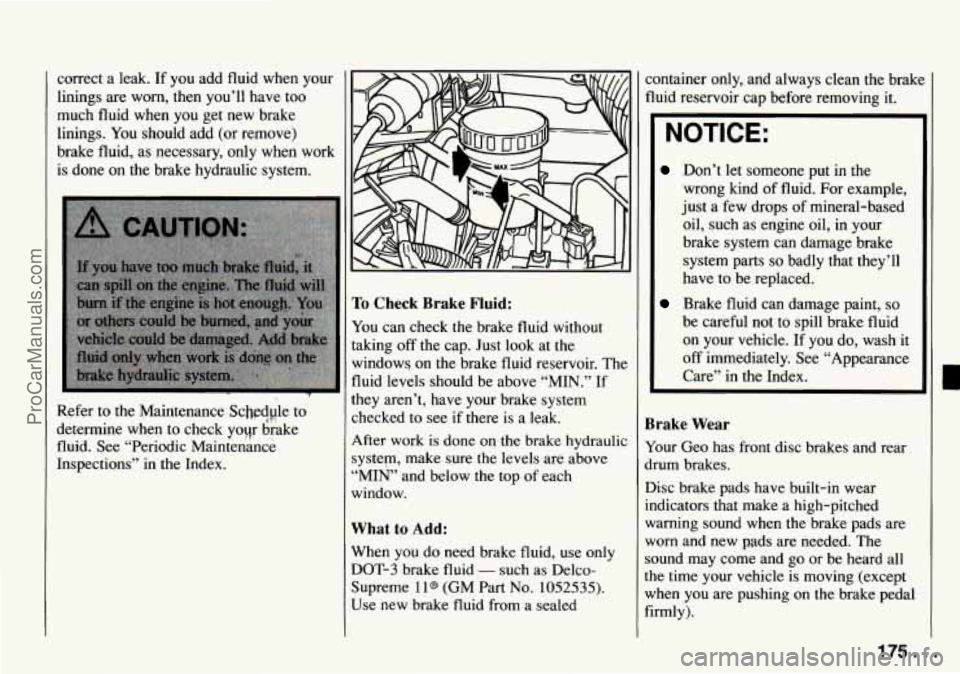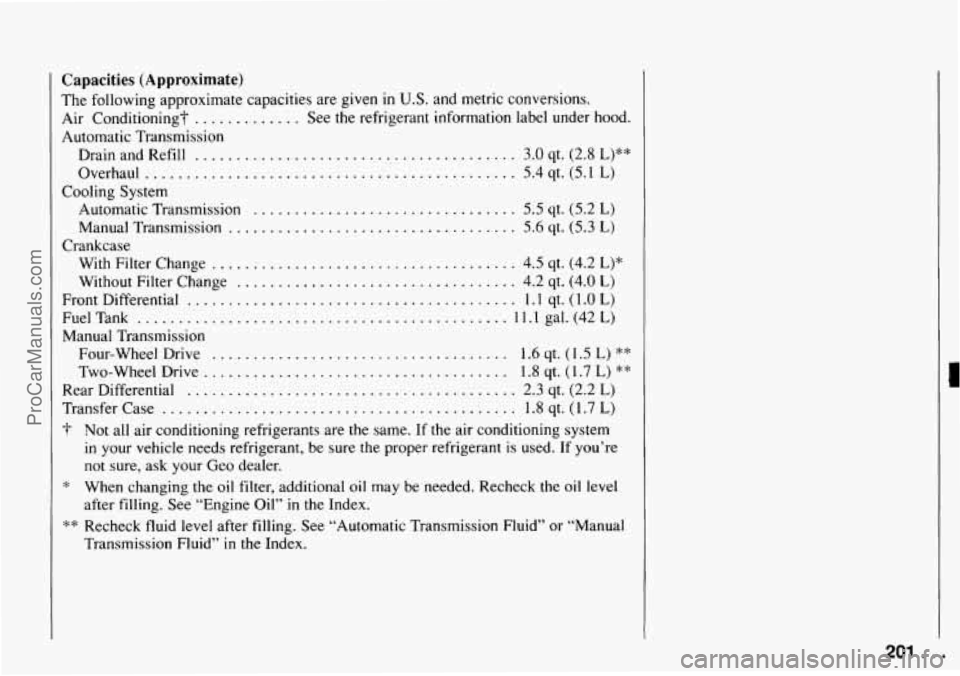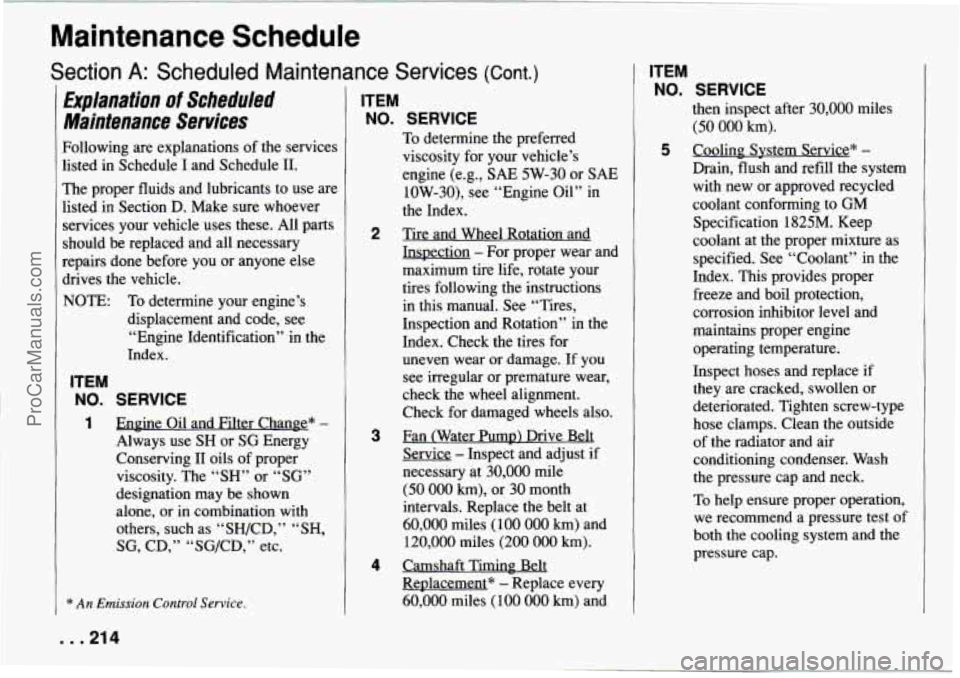check engine CHEVROLET TRACKER 1994 Owner's Manual
[x] Cancel search | Manufacturer: CHEVROLET, Model Year: 1994, Model line: TRACKER, Model: CHEVROLET TRACKER 1994Pages: 258, PDF Size: 14.43 MB
Page 172 of 258

and refill. If you use this mixture. you
don't need to add anything else.
A CAUTION:
Adding only plain water to your
cooling system can
be dangerous.
Plain water, or some other
liquid like
alcohol, can
boil before the proper
coolant mix will. Your vehicle's
cool-
ant warning system is set for the
proper coolant
mix. With plain water
or the wrong mix, your engine could
get too hot but you wouldn't get the
overheat warning. Your engine could
catch fire and you or others could be
burned. Use a 50/50 mix of clean
water and a proper antifreeze.
NOTICE:
If you use an improper coolant mix,
your engine could overheat and be
badly damaged. The repair cost
wouldn't be covered by your war-
ranty.
Too much water in the mix can
freeze and crack the engine, radiator,
heater core and other parts. Some conditions, such
as air
trapped in
the cooling system, can af't'ect the coolant
level
in the radiator. Check the coolant
level when the engine is cold and follow
the steps under "Adding Coolant" for the
proper way
to add coolant.
If you have to add coolant Inore than four
times
a year. have your dealer check your
cooling system.
NOTICE:
If you use the proper coolant. you
don't have to add extra inhibitors
or
additives which claim to improve thc
system. These can
be harmful.
%-Valve Engine
Adding Coolant
To Check Coolant: When your engine is
cold.
the coolant level should be at
"LOW," or a little higher. When your
engine
is warm. the level should be up to
"FULL." or a little higher.
171 ..
ProCarManuals.com
Page 174 of 258

Power Steering FJuid
How to Check Power Steering Fluid:
Unscrew the cap and wipe the dipstick
with
a clean rag. Replace the cap and
completely tighten
it. Then remove the
cap again and look at the fluid level on
the dipstick.
D When the engine compartment is hot,
the level should
be at the “MAX”
mark.
D When the engine compartment is cool
the level should be at
the “MIN”
mark.
‘hat to Add:
:fer to the Maintenance Schedule to
terrnine what kind of fluid to use. See
[ecornmended Fluids and Lubricants”
in
2 Index.
NOTICE:
When adding power steering fluid or
making
a complete fluid change,
always use
the proper fluid. Failure
to use the proper fluid can cause
leaks and damage hoses and seals.
173 ...
ProCarManuals.com
Page 176 of 258

correct a leak. If you add fluid when your
linings are worn, then you’ll have too
much fluid when you get new brake
linings. You should add (or remove)
brake fluid, as necessary, only when work
is done on the brake hydraulic system.
Refer to the Maintenance Schedple to
determine when to check
yoqr drake
fluid. See “Periodic Maintenance
Inspections” in the Index.
To Check Brake Fluid:
You can check the brake fluid without
taking
off the cap. Just look at the
windows on the brake fluid reservoir. The
fluid levels should be above “MIN.” If
they aren’t, have your brake system
checked to see if there is a leak.
After work is done
on the brake hydraulic
system, make sure the levels are above
“MIN’ and below the top
of each
window.
What to Add:
When you do need brake fluid, use only
DOT-3 brake fluid
- such as Delco-
Supreme 11s (GM Part
No. 1052535).
Use new brake fluid from a sealed container
only, and always clean the brakl
fluid reservoir cap before removing it.
NOTICE:
Don’t let someone put in the
wrong kind of fluid. For example,
just a few drops of mineral-based
oil, such as engine oil, in your
brake system can damage brake system parts
so badly that they’ll
have to be replaced.
Brake fluid can damage paint, so
be careful not to spill brake fluid
on your vehicle. If
you do, wash it
off immediately. See “Appearance
Care” in the Index.
Brake Wear
Your Geo has front disc brakes and rear
drum brakes.
Disc brake pads have built-in wear
indicators that make a high-pitched
warning sound when the brake pads are
worn and new pads are needed. The
sound may come and
go or be heard all
the time your vehicle is moving (except
when you are pushing on the brake pedal
firmly).
175 ...
ProCarManuals.com
Page 197 of 258

Service and Appearance Care
Vehicle Identification
Number
(VZN)
rhis is the legal identifier for your Geo. I
lppears on a plate in the front corner of
he instrument panel, on the driver’s side.
fou can see it
if you look through the
windshield from outside your vehicle.
he VIN also appears
on the Vehicle
ktification and Service Parts labels and
he certificates
of title and registration.
Engine Identification
rhe eighth character in your VIN is the
:ngine code.
This code will help you
denti€y your engine, specifications, and
meplacement parts.
. .I96
9
1
I
il
1
t
Service Parts
Identification Label
You’ll find this label inside the glove box
m the door. It’s very helpful if you ever
need to order parts.
On this label is:
B -your VIN,
the model designation,
B paint information, and
a list of all production options and
special equipment.
Be sure that this label is not removed
From the vehicle.
Add-on Electrical
Equipment
NOTICE:
Don’t add anything electrical to your
Geo unless you check with your
dealer first. Some electrical equip-
ment can damage your vehicle and
the damage wouldn’t be covered by
your warranty. Some add-on electri-
cal equipment can keep other compo-
nents from working as they should.
I.
Fuses and Circuit
Breakers
The wiring circuits in your vehicle are
protected from short circuits by fuses,
circuit breakers and thermal
links in the
wiring itself. This greatly reduces the
chance
of fires caused by electrical
problems.
The main
fuse box is in your engine
compartment
OR the right side. It protects
all electrical loads.
ProCarManuals.com
Page 200 of 258

Replacement Bulbs
Back-up ........................................................ 1156
Dome
...................................................... 96051559
Center High-Mounted Stop
........................................... 921
Front Parking and
Turn Signal .................................... 1157 NA
Headlight (Halogen) ............................................... 9004
Heater
or Air Conditioning Control ............................... 96052599
Charging System
............................................ 9433 184
Engine Oil Pressure
.......................................... 9433 184
4WD
...................................................... 9433184
Headlight High Beam
......................................... 9433 184
Instrument Cluster
............................................. 9605 156
Rear Defogger Switch ......................................... 9606 1736
Rear Hazard and
Turn Signal ........................................ 1156
Rear Wipermasher Switch
..................................... 9606 1736
Indicator and Warning
Brake
..................................................... 9433184
CheckEngine
............................................... 9433184
SafetyBelt
................................................. 9433184
Turnsignal
................................................. 9433184
Licenseplate
..................................................... 194
Lighter
...................................................... 9433184
Rearparkingandstop
............................................. 1157
Sidemarker ......................................... ............ 194
199 ...
ProCarManuals.com
Page 202 of 258

Capacities (Approximate)
The following approximate capacities are given in U.S. and metric conversions.
Air Conditioning”
............. See the refrigerant information label under hood.
Automatic Transmission Drain and Refill
....................................... 3.0 qt. (2.8 L)**
Overhaul ............................................. 5.4 qt. (5.1 L)
Automatic Transmission ................................ 5.5 qt. (5.2 L)
Manual Transmission ................................... 5.6 qt. (5.3 L)
With Filter Change ..................................... 4.5 qt. (4.2 L)*
Without Filter Change .................................. 4.2 qt. (4.0 L)
Front Differential ........................................ 1.1 qt. (1 .O L)
Fuel Tank ............................................. 11.1 gal. (42 L)
Manual Transmission
Cooling System
Crankcase
Four-wheel Drive
.................................... 1.6 qt. ( 1.5 L) **
Two-Wheel Drive ..................................... 1.8 qt. (1.7 L) **
Rear Differential ........................................ 2.3 qt. (2.2 L)
Transfer Case ........................................... 1.8 qt. ( 1.7 L)
T Not all air conditioning refrigerants are the same. If the air conditioning system
in your vehicle needs refrigerant, be sure the proper refrigerant is used. If you’re
not sure, ask your Geo dealer.
* When changing the oil filter, additional oil may be needed. Recheck the oil level
after filling. See “Engine Oil”
in the Index.
** Recheck fluid level after filling. See “Automatic Transmission Fluid” or “Manual
Transmission Fluid”
in the Index.
201 ...
ProCarManuals.com
Page 204 of 258

.
IMPORTANT:
KEEP THE ENGINE OIL
AT THE PROPER
LEVEL AND CHANGE AS
RECOMMENDED
This part covers the
maintenance required
for your
Geo . Your vehicle needs these
services to retain its safety.
dependability and emission
control performance
.
Maintenance Schec
Section
Introduction: A Word about Maintenance ........................
A .
B .
C .
D .
E .
Your Vehicle and the Environment .........................
How This Part Is Organized ............................
Scheduled Maintenance Services ........................
Using Your Maintenance Schedule .......................
Selecting the Right Schedule ............................
Schedule1 .......
Schedule11 ............................................
Owner Checks and Services .........
At Each Fuel Fill .......
At Least Once a Month .................. .......
At Least Twice a Year .........
AtLeastOnceaYear ..................................
Periodic Maintenance Inspections ...........................
Recommended Fluids and Lubricants ........................
MaintenanceRecord ......................................
................................
Explanation of Scheduled Maintenance Services ..............
....................
.........................
...................
ule
Protection
Plan
Have you purchased the GM Protection Plan? The Plan
supplements
your new car warranties .
See your GM dealer for details .
204
204
204
205
205
205
206
210
214
218
218 219
219 220
223
225
228
203 ...
ProCarManuals.com
Page 209 of 258

Maintenance Schedule
Section A: Scheduled Maintenance Services (cont.)
Schedule / (Cont.)
* An Emission Control Service.
t The US. Environmental Protection Agency
or the California Air Resources Board has
determined that the failure to perform this
maintenance item will
not nullify the emission
warranty or limit recall liability prior to the
completion
of vehicle useful life. General
Motors, however, urges that all recommended
maintenance services be performed at the
indicated intervals and the maintenance be
recorded in “Section E: Maintenance Record.”
WHAT TO SERVICE
See “Explanation of Scheduled
Schedules
I and 11.
ITEM NO. Maintenance Services” following
WHEN TO PERFORM
Miles (kilometers) or Months
(whichever occurs first).
14
Air Cleaner Filter Replacement* See “Explanation of Scheduled
Maintenance
Services” following Schedules
I and 11.
15 I Fuel Tank, Cap and Lines Inspection*t I
See “Explanation of Scheduled Maintenance
Services” following Schedules
I and 11.
16
Every
80,000 miles (133 000 km). Heated
Oxygen Sensor Replacement*
18 Every
100,000 miles
(166 000 km).
Fuel Injector Inspection”
17 Every
30,000 miles (50 000 km)
or 30 months. Fuel Filter Replacement*
l9 I
Evaporative Emissions Canister
Replacement* I Every 100,000 miles (166 000 km).
Engine Control Module (ECM) and 2o Associated Sensors Inspection* Every 100,000 miles (1 66 000 km).
21 Every
100,000 miles (166 000 kml
Three Wav Catalvtic Converter Inspection* 22
Every 60,000 miles (100 000 km). Emission
System Hoses Inspection*
~~ I - \--- ~~
23 I Engine Timing and Distributor Check* I Every 60,000 miles (100 000 km).
24
Every 60,000 miles (100 000 km). Brake Fluid
Service 28
Every 60,000 miles (100 000 km) or 60 months.
Wiring Harness and Connectors Inspection* 27
Every 7,500 miles (12 500 km) or 7.5 months.
Power Steering System Inspection 26
Every 15,000 miles (25 000 km).
Valve Lash (Clearance) Inspection* 25
Every 15,000 miles (25 000 km).
Engine Idle Speed Check*?
. . ,208
ProCarManuals.com
Page 213 of 258

Maintenance Schedule
Section A: Scheduled Maintenance
Schedule /I (Cont.)
* An Emission Control Service.
t The US. Environmental Protection Agency
or the California Air Resources Board has
determined that the failure to perform this
maintenance item will not nullify the emission
warranty or limit recall liability prior to the
completion
of vehicle useful life. General
Motors, however, urges that all recommended
maintenance services be performed at the
indicated intervals and the maintenance be
recorded in “Section E: Maintenance Record.”
-
ITEM NO.
20
21
-
Services (Cont.)
WHAT TO SERVICE
See “Explanation of Scheduled
Maintenance Services” following
Schedules
I and 11.
Air Cleaner Filter Replacement*
Fuel Tank, Cap and Lines Inspection*?
Fuel Filter Replacement*
Fuel Injector Inspection* Heated Oxygen Sensor Replacement*
Evaporative Emissions Canister
Replacement*
Engine Control Module (ECM) and
Associated Sensors Inspection”
Emission System Hoses Inspection*
Three Way Catalytic Converter Inspection*
Engine Timing and Distributor Check*
Engine Idle Speed Check*?
Valve Lash (Clearance) Inspection*
Power Steering System Inspection
Wiring Harness and Connectors Inspection*
Brake Fluid Service
WHEN TO PERFORM
Miles (kilometers) or Months
(whichever occurs first).
See “Explanation of Scheduled Maintenance
Services” following Schedules
I and 11.
See “Explanation
of Scheduled Maintenance
Services” following Schedules I and
11.
Every 30,000 miles (50 000 km) or 30 months.
Every
100,000 miis (166 000 km).
Everv 80.000 miles (1 33 000 km).
Every
100,000 miles (166 000 km).
Every
100,000 miles (166 000 km).
Everv
60.000 miles (100 000 km). ~~
Every 100,000 miles (166 000 km).
Every
60,000 miles (100 000 km).
Every
15,000 miles (25 000 km).
Every
15,000 miles (25 000 km).
Every
7,500 miles (12 500 km) or 7.5 months.
Every
60,000 miles (100 000 km) or 60 months.
Every
60,000 miles (100 000 km).
. . .212
ProCarManuals.com
Page 215 of 258

Maintenance Schedule
Section A: Scheduled Maintenance Services (Cont.)
&planation of Scheduled
Maintenance Services
?allowing are explanations of the services
isted in Schedule
I and Schedule II.
he proper fluids and lubricants to use are
.isted
in Section D. Make sure whoever
rervices your vehicle uses these. All parts
should be replaced and all necessary
repairs done before you or anyone else
~ives the vehicle.
NOTE: To determine your engine’s
displacement and code, see
“Engine Identification” in the
Index.
ITEM
NO. SERVICE
1 -e Oil and Filter Change* -
Always use SH or SG Energy
Conserving
II oils of proper
viscosity. The
“SH” or “SG”
designation may be shown
alone, or in combination with
others, such as “SHKD,”
“SH,
SG, CD,” “SG/CD,” etc.
* An Emission Control Service.
ITEM
NO. SERVICE
2
3
4
To determine the preferred
viscosity for your vehicle’s
engine (e.g.,
SAE 5W-30 or SAE
10W-30), see “Engine Oil” in
the Index.
Tire Wheel Rotation and
Jnspectioq
- For proper wear and
maximum tire life, rotate your
tires following the instructions
in this manual. See
“Ties,
Inspection and Rotation’’ in the
Index. Check the tires for
uneven wear or damage.
If you
see irregular or premature wear,
check the wheel alignment.
Check for damaged wheels also.
Fan (Water Pump) Drive Belt
Servk
- Inspect and adjust if
necessary at
30,000 mile
(50 000 km), or 30 month
intervals. Replace the belt at
60,000 miles (100 000 km) and
120,000 miles (200 000 km).
-shaft Timin? Belt
Replacemeat”
- Replace every
60,000 miles (100 000 km) and
ITEM NO.
SERVICE
then inspect after 30,000 miles
(50 000 km).
Drain, flush and refill the system
with new or approved recycled
coolant conforming to
GM
Specification 182SM. Keep
coolant at the proper mixture
as
specified. See “Coolant” in the
Index. This provides proper
freeze and boil protection,
corrosion inhibitor level and
maintains proper engine
operating temperature.
Inspect hoses and replace
if
they are cracked, swollen or
deteriorated. Tighten screw-type
hose clamps. Clean the outside
of the radiator and air
conditioning condenser. Wash
the pressure cap and neck.
To help ensure proper operation,
we recommend a pressure test
of
both the cooling system and the
nressure cap.
5 Coolin? Sys&nSemice* -
. . ,214
ProCarManuals.com